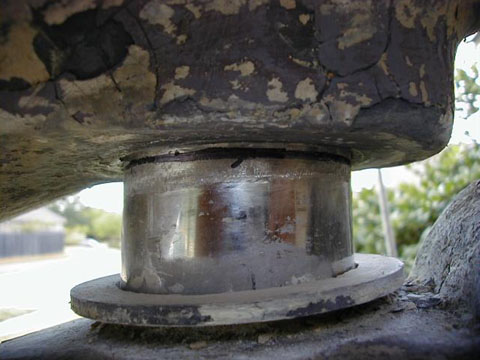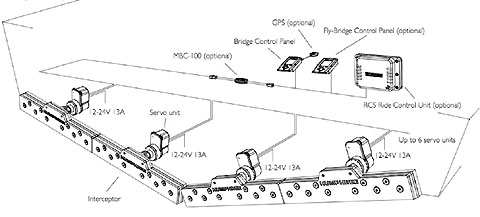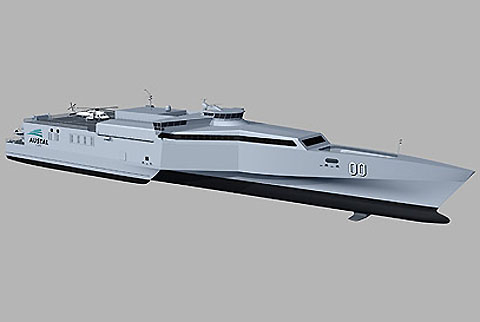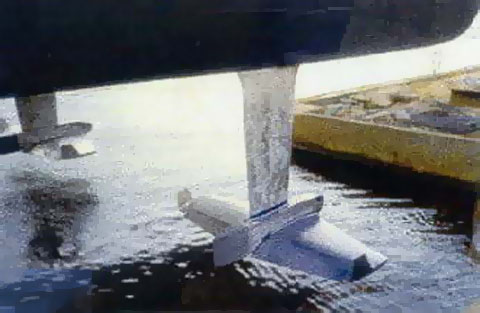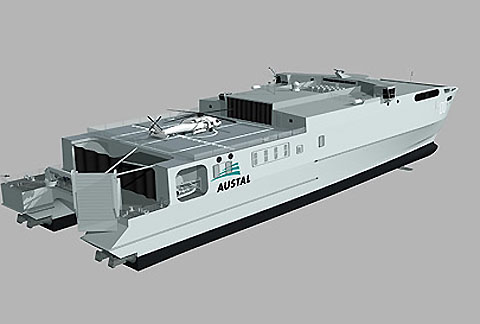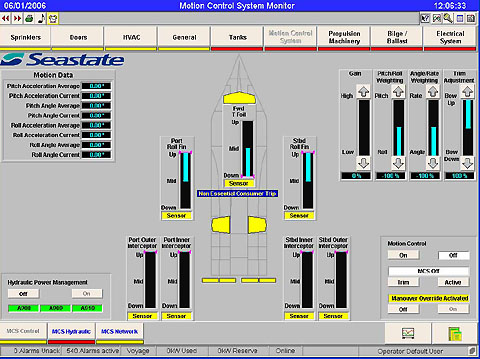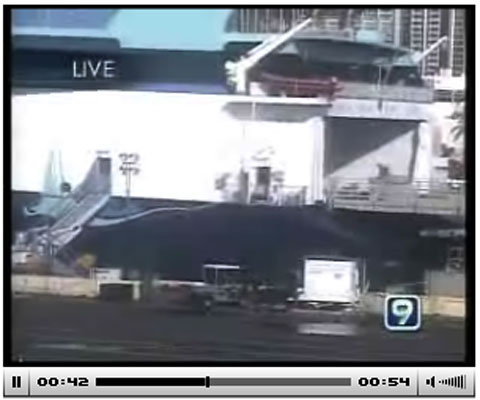www.islandbreath.org ID#0809-11
SUBJECT: SUPERFERRY DAMAGE
SOURCE: JUAN WILSON juanwilson@mac.com
POSTED: 5 FEBRUARY 2008 - 9:45am HST
USCG says Auxiliary Rudders Damaged
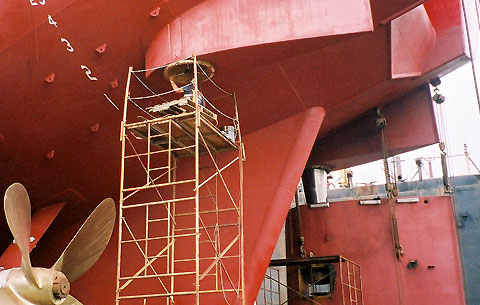
image above: not the Superferry stern. Rudder post sleeve alignment on another ship by Aim Analignment
by Juan Wilson on 5 February 2008 I just got a phone call from Tim Rysdale, of Wailua. He was one of those arrested back in August in the aftermath of the Superferry's attempt to land on Kauai. Tim's family has always been a supporter of the United States Coast Guard. He maintains friends in the service, despite his disfavor with the USCG coming under the wing of Homeland Security Department. A friend of Tim's active in the USCG, and in a position to know, has told him that the Superferry uses an new prototype of auxiliary rudder, in addition to other steering mechanisms. This is in addition to the control surfaces and Humphree devices mentioned as possible "rudders" in previous speculation. As I understood Tim's description, these rudders are hydraulically rotated through sleeved posts that enter the ship through the aluminum hull. Stress on the posts created cracks that allowed some water to enter the ferry's hull. With my limited knowledge of ship design, and structural metals, I would maintain that this represents an engineering flaw that has resulted in at least a minor structural failing of the hull. Yes the Superferry is running again. I'll bet that the next ferry Austal builds will have some re-engineering on the structure of the auxiliary rudders before the boat is ready for sea trials.
|
SUBJECT: SUPERFERRY DAMAGE
SOURCE: JUAN WILSON juanwilson@mac.com
POSTED: 4 FEBRUARY 2008 - 8:00am HST
George Peabody HSF Video
video above: Peabody footage on YouTube. Click here to see on web or here for quicktime
[Note from George Peabody 2/11/08. The Superferry Alakai was pounding its way near the southeast coast of Molokai in the whale sanctuary zone between Maui and Molokai on its way to port at Kahului Harbor on its las run from Oahu to Maui a week ago, just before damage to rudder was reported. On this trip, sighting whales to avoid in these rough seas and blinding rains is impossible.You can my website url: http://www.MolokaiAdvertiserNews.com] by Juan Wilson on 4 February 2008 Revised 080211 George Peabody, of the Molokai-Advertiser News, sent us this portion of a video he shot of the Superferry Alakai leaving Kahului Harbor on its last run to Ohau a week ago, before the "rudder" damage was detected. George has a dial-up internet connection and therefore sent only a small resolution portion of the video. A longer higher resolution version may soon be available. Note, this is the source of the video shown on KGMB-9 TV. The pitching bow of the Alakai deck in the swell appears to pass through more than 30 vertical feet of movement. Certainly enough to throw passengers of their feet if not holding themselves securely to the ship. I'm not quite clear how or if vehicles are secured on board. I have traveled on large Nantucket vehicle ferries and they do not secure cars and trucks. Could get dicey in a pacific Ocean winter swell. There must have been tremendous stress on any of the control surfaces deployed and active. |
SUBJECT: SUPERFERRY DAMAGE
SOURCE: LEE TEPLEY leetepley@earthlink.net
POSTED: 3 FEBRUARY 2008 - 10:30am HST
Superferry "Rudder" problem.

image above: Three Humphree Interceptors mounted on a monohull (black strips along hull)
[Editor's Note: Bit by bit, no thanks to the Superferry or the Coast Guard, we are getting a better picture of what might have happened to the Superferry to put it out of service. It is likely that the damage was to Humphree interceptors mounted on the stern to steer the ferry at high speed. Speculation: The surface cracks that were reported might be on the stern transom (the flat termination to the stern, above the water line) that the interceptors are mounted to. If this were the case it indeed would be a disastrous structural failure of the Superferry's aluminum hull design.] by Lee Tepley on 2 February 2008 (edited by Juan Wilson) I suspect that the "Seastate" motion controls, system monitor shown in Juan Wilson's article is for an Austal trimaran rather than for the Superferry because it includes a sensor (and t-foil) in the center - so the Superferry would employ a slightly different variation. This graphic file show what appear to be "Humphree Interceptors" at the stern. I came up with an additional diagram of Humpree Interceptors which is a bit easier to understand (see below). It show the interceptors on the transom of a monohull just above the water line. It seems likely that similar interceptors are used by the Superferry. The nterceptors are fairly, simple devices. I guess is that the Superferry them mounted near the output of the 4 water jets. To turn the vessel the Interceptors on one side are lowered a short distance into the water which increases the drag on that side of the vessel - so it turns toward the other side. This is supposedly a better way of steering when the vessel is moving at high speed than by rotating the water jets - at least, that is what is written in the papers in all files I have reviewed. But "interceptors" are not the same as rudders. Does the Superferrv also have more conventional rudders? When Superferry officials refer to rudder damage, does this really mean damage to the interceptors? And when they stated that "the rudders serve to make only slight course adjustments" were they dead wrong or just trying to minimize a serious problem? Does HSF know the difference between a "rudder" and an "interceptor"? |
SUBJECT: SUPERFERRY DAMAGE
SOURCE: JUAN WILSON juanwilson@mac.com
POSTED: 1 FEBRUARY 2008 - 9:00am HST
Damage Update: It's the Rear "Rudders"
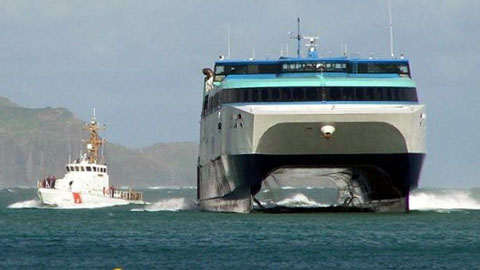
image above: In better days HSF enters Kahului Harbor on 12/13/07. Photo by Brad Parsons
by Juan Wilson on 31 January 2008 "The “t foil” and “roll fins” are characteristic of a three-hull design, with the foil being on the central hull and the fins on the outer hulls. The Alakai, however, is a two-hull design. I can’t claim to have ever seen the Alakai below the waterline, so perhaps Wilson is correct about the fins, but I doubt it. I’m not trying to attack Wilson’s credibility or his motives, but I think it’s worth a closer look. If I’m wrong, I’ll happily retract what I said."
Doug is correct. The screenshot of the SeaState motion control system in my article below is for a different hull design than the Superferry. The Trimaram 126 meter HSSV (shown above) is the likely vessel for which the Seastate screenshot software was configured. For a twelve page PDF (1.8meg) bochure of the Austal high speed trimaram and catamaran proposals for the U.S. military, shown in this articel, click here. It is my understanding that the Seastate software is used by all the new Austal multi-hulled passenger-vehicle ferries. I seem to remember a photo of the Superferry catamaran bows showing a T-Foil on each. However, I have not been able to locate that image. I think it may have come from Lee Tepley. Below is a photo of an unidentified catamaran with such control surfaces. A view of the Austal conceptual drawing of their High Speed Support Vessel (HSSV) proposed for the US Navy show the legacy of Westpac Express and the Hawaii superferry. Note below the forward T-Foils (identified with #10) on the keel in the exploded view of the vessel: A KITV-4 News update on the rudder story indicates that two rear auxiliary rudders have shown surface cracks. The KITV reports indicates: Hawaii Superferry officials confirm there are "surface cracks" involving two "auxiliary rudders" on the back end of the ship.
Another significant line in the story is: "A final determination will need to be made, whether or not they can take passengers onboard again."
|
SUBJECT: NAVY JHSV CONTRACT
SOURCE: JONATHAN JAY jonathan@DAkauai.com
POSTED: 1 FEBRUARY 2008 - 8:30am HST
Superferry gets Austal shot at big contract
Kathleen Roberts Public Affairs Contact for D CIV SEA 00D phone: (202) 781-3350 email: kathleen.roberts@navy.mil |
SUBJECT: SUPERFERRY DAMAGE
SOURCE: JUAN WILSON juanwilson@mac.com
POSTED: 31 JANUARY 2008 - 8:30am HST
Steering Problems for Superferry
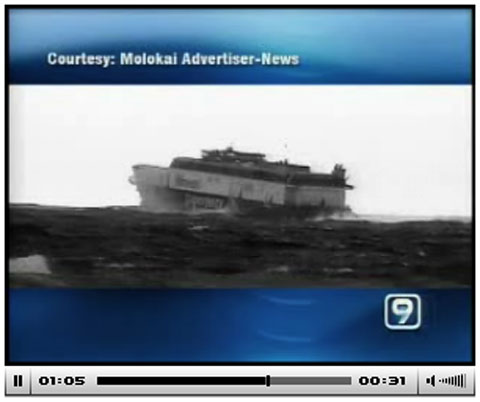
image above: Still from KGMB-9 video of Superferry pitching in waves as it s it passes east Molokai
heading to port at Kahului Harbor on Maui on Sat. 1-26.
by Juan Wilson on 31 January 2008 From media reports it would seem as if the heavy seas between Oahu and Maui have seriously damaged the Hawaii Superferry the Alakai. KGMB-9 News reported on January 30th that:
My understanding is that the Alakai does not have a traditional rudder.The steering and stabilization systems on the Alakai, sensors communicate with computer software to anticipate positional, wave thrust and current action to determine how the Alakai's control surfaces and thrusters address the ship's motion, moment to moment. This is not a manual operation.
Austal, the builder of the Superferry, uses a software program it developed called "Seastate" to sense and control the ship. There is a forward "T foil" and a port and starboard roll fins. These are "rudders" for helping to control pitch and roll of the ship. Steering (yaw control) is accomplished through an array of diesel powered waterjets that are capable directing thrust is any direction. The skimpy damage reports describe the structure of a "rudder post" as having cracks. This report is a serious structural failure. Just remember, as it sank, the Titanic broke in two because of "cracks" in its structural steel hull. The "rudder post" described in the KGMB-9 report may be a support for a stabilization fin attached to the side of the hull. Certainly, heavy pounding seas could weaken such a cantilevered element if not properly anticipated by design engineers. This is a serious problem. If the "rudder post" problem is with the support of the jet thrusters it may be even more serious. In my mind, damage to thruster supports would indicate a fatal design flaw that would require a fundamental structural review. Structural cracks in either case would indicate need for a dry dock and major repairs before the vessel is recertified by the US Coast Guard.
This is likely a disaster for the HSF Corporation. Even if it can be back in a few weeks, this is a public relations nightmare that will shake the confidence of ferry supporters. It may be the Superferry may be out of action until it is out of business. It also may be a disaster for the military plans for this vessel. If a few hundred hours of civilian operation can deliver this kind of damage to the ship. what use is this design to the armed service? |
see also:
Island Breath: January HSF News 1/24/08
Island Breath: HSF night trips 1/11/08
Island Breath: HSF military trips 1/8/08
Island Breath: HSF EIS Smoking Gun 1/6/08
Island Breath: HSF two trips 1/5/08
